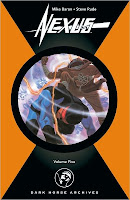The Woman Who Died A Lot
Long-running series can easily fall into a rut -- and here you can pretend that I'm pointing to your favorite example of that truism, without actually making an example of any specific authors who might take a snit -- but Fforde's "Thursday Next" books have been able to avoid that recently through the odd tactic of writing about different versions of the heroine.
The previous book, One of Our Thursdays Is Missing (see my review), focused on the fictional Thursday -- the one who "plays" the character in the novels as they were published (and ghostwritten) in the world in which Thursday is real. But Woman Who Died a Lot returns to the "real" Thursday -- the one who was the heroine of the other novels in the series, most specifically picking up the plot from 2007's First Among Sequels -- and her ongoing battles with the evil world-bestriding Goliath Corporation, usually in the person of her nemesis Jack Schitt.
Died a Lot takes place during one week in 2004 -- two years after One of Our Thursdays, in the wake of a decision to reform all of the SpecOps divisions disbanded a dozen years before. (That's all backstory -- and mostly between-book backstory, too -- so it's mostly just scene-setting for fans of the series.) Thursday interviews for the job of heading her old division -- the Literary Detectives -- but instead is hired as chief librarian of the Swindon All-You-Can-Eat at Fatso's Drink Not Included Library. (One of the slier bits of backstory is the ongoing discussion of the Stupidity Deficit -- this fictional UK has a government run by the Sensible Party, which means that all of the unexpressed stupidity backs up at useful-to-the-plot times to explode in various amusing ways. In this book, the government has taken steps to introduce carefully moderated levels of stupidity in their actions, including truly bizarre naming deals.)
But the real core of Dies a Lot is Thursday's family -- her son Friday will now no longer become the longest-serving head of the ChronoGuard, since it's been proven that no one invented their time machines and they shut down before they began; her genius daughter Tuesday is trying to perfect a technological Smite Shield to protect Swindon from the wrath of God (who has been prodded by the dominant Global Standard Deity religion to reveal himself and begin a pattern of overwhelming smitings); and her third child Jenny is completely imaginary, a false memory planted (originally in her head, later elsewhere) by Aornis Hades, a memory-controlling mnemonomorph and the second-most deadly of that clan.
Oh, and Goliath has been sending ever-more-sophisticated robotic duplicates of Thursday to learn her secrets -- which is the explanation of the title, since Thursday and her husband Landen (with occasional help from others) has been disposing of those for some time.
It all comes together in that one week -- Thursday's new job, the upcoming smiting, Friday's predicted murder of another young ChronoGuard would-have-been, and a secret Goliath plot that involves palimpsests of incredibly rare but also incredibly boring incunabula. I wouldn't dream of explaining how it all comes out: Fforde is wonderful at juggling several odd plotlines and bringing them all to a head at once, so this is a book that has to be read. The whole Thursday Next series started out as a love letter to Great Books, but it's widened since then: Dies a Lot is not just a deeply entertaining romp, but a Rube Goldberg device encompassing the whole of the literary world, with an emphasis on librarians this time around. It's a series deeply appealing to anyone who loves books and reading, which should be everyone reading this.
Captain Vorpatril's Alliance
And this is the most recent -- though not the latest, since it's actually set earlier in time than the prior book, Cryoburn -- book in Bujold's long-running "Vorkosigan" series. It's the long-promised "Ivan book," focusing on the usual series hero's ne'er-do-well cousin (who actually isn't all that ne'er-do-well, actually; it's just that he seems that way compared with omnicompetent, manic Miles).
And it's been thoroughly chewed up and digested by the fans of the series by this point; I wouldn't at all be surprised if there were already page-by-page concordances of Alliance explaining which plots of which entire books Bujold tosses off in a sentence of dialogue.
Personally, I enjoy reading Bujold's books, but I don't feel the need to re-read the entire series before a new one so all of the references are fresh -- I also don't think Bujold deliberately writes for that audience either, but her quietly competent and all-encompassing style makes it a useful reading technique.
I've always liked Ivan better than Miles -- Miles is the kind of person I'd try very hard to avoid in real life, while Ivan is someone I could aspire to be, if I was born into the minor nobility of a far-future alien world -- so seeing him find what I must assume is the love of his life (Bujold doesn't do divorces for her viewpoint characters) was nice.
So, this is Bujold in mostly-light mode, along the lines of A Civil Campaign (though not as frivolous as that book), and it's better-balanced than the last Vorkosigan novel, 2010's Cryoburn. But the people who are likely to want to read this book probably already have. Hope you all liked it.



































